
On the first page about front panels, two computers from the Digital Equipment corporation are illustrated. One of them was the PDP-8/I, which used the same style of rocker switch that was to appear much later on the PDP-12 and PDP-15 computers that we saw on the previous page.
This architecture was first represented by the PDP-5, which filled one rack.

One architectural difference between it and the PDP-8 was that memory location 0 was used for the program counter. Thus, while there is no row of lights on the front panel for the program counter, one light indicates "Program Counter" as a machine state, along with fetch, execute, defer, and break. This machine first shipped in September, 1963, and two FORTRAN compilers were available for it, one that only required paper tape for source input and object output, and one that made use of a DECtape drive, then referred to as a Micro Tape System. The ability to expand memory from 4,096 words to 32,768 words was also provided at the very beginning as an option for the PDP-5.
The original PDP-8, although still made from discrete transistors, was smaller; it came in a tabletop version, in which the small box with the front panel was surmounted by a clear plastic shell through which the computer's logic boards were visible.
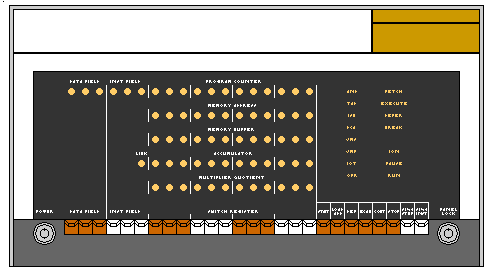
This computer was first delivered in April, 1965. Small computers had existed before then, but the PDP-8 is the machine credited with starting the minicomputer revolution.
In September of 1966, DEC shipped the first PDP-8/S.
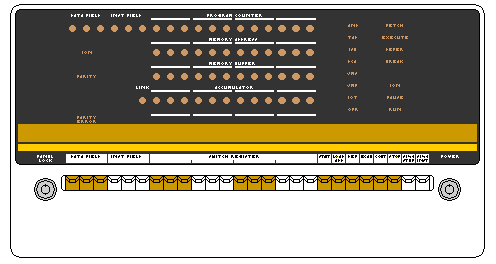
This computer was less than a foot high, and thus it had the form factor more commonly associated with minicomputers, and yet it, too, was made with discrete transistors. It was a less-expensive version of the PDP-8; this savings was achieved through using a serial arithmetic unit, which, by making it much slower, limited its success. (The memory cycle time of the PDP-8/S was 10 microseconds. By comparison, the PDP-8, which was less than twice as expensive, had a cycle time of 1.6 microseconds. On the other hand, the cycle time of the PDP-5 was 6 microseconds.)
In April 1968, DEC delivered the first PDP 8/I. It used integrated circuits, and it was taller than its front panel:
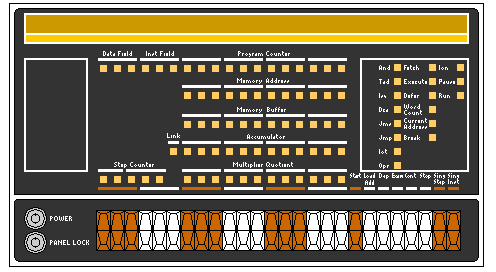
being intended to be used in a rack with additional equipment such as a DECtape unit or a high-speed photoelectric paper tape reader.
The original PDP-8 came with an optional feature allowing its memory to be expanded from the basic 4,096 words up to 32,768 words. Enhancements to this were available for the PDP-8/I. As well, a special tape format, DECtape, available with computers from DEC, allowed tape to serve as an inexpensive random-access storage medium.
Removable disk packs were also an option; as one example, the RK05 disk drive allowed the use of the same type of disk pack as was used in the IBM 2315 disk drive, with a capacity of about 1,600,000 12-bit words. It had predecessors, some earlier ones having a lower recording density.
A PDP-8/I running TSS/8 (or, for that matter, a PDP-8/e running OS/8) would very likely have either DECtape, an RK05 removable hard disk drive, or both. But more importantly, the DF32, which had been available for previous PDP-8 models as well, was a head-per-track disk drive with a capacity of only 32,768 words. Nearly all TSS/8 installations would have had one of these, because being able to rapidly swap the 4K user area of memory to and from that device helped to make timesharing more practical on such a small computer; it was not a requirement, however; TSS/8 could run even if a DECtape was the only mass storage device attached.
A timesharing option board, the KT8/I, which provided additional protection and memory extension features was required for the TSS/8 time-sharing operating system.
Switches of the type used on the PDP-8, the PDP-9 and the LINC-8 returned with the PDP-8/L, which was a less expensive computer, but this time only with less expansion capability, not with seriously compromised performance.
The styling of the PDP-8/L, first delivered in November, 1968,
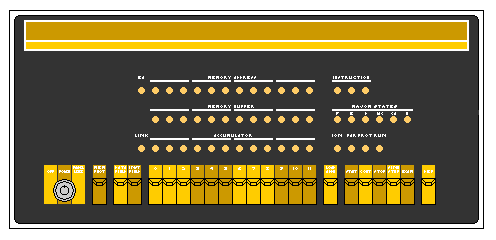
largely resembled that of the PDP-8/e. This computer, first delivered in March, 1971, included some modifications to the Extended Arithmetic Element, which was the option that gave the PDP-8 hardware multiplication capability, from the version available for both the original PDP-8 and the PDP-8/I.
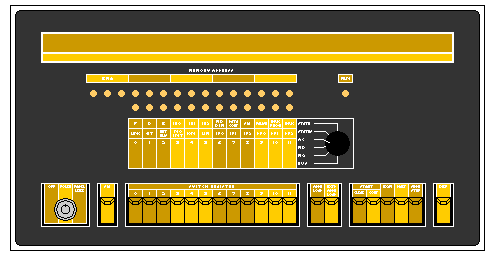
The PDP-8/L and the PDP-8/e both had a color scheme of reddish brown and orange, which gave the PDP-8 a distinctive color scheme of its own, analogous to the color schemes of the PDP-12 and PDP-15 seen previously. The PDP-8/L, 8/m, and 8/f are other versions of the PDP-8 which shared this color scheme.
An improved timesharing operating system, OS/8, was provided for the PDP-8/e computer. In this operating system, file names consisted of six letters, and then a period and a two-letter extension indicating the type of a file. Files were copied using a program called the Peripheral Interchange Program, thus, one typed "PIP" instead of "COPY" to copy a file. This will be familiar to users of CP/M. While PC-DOS changed that, it will also be remembered that this operating system strongly resembled CP/M in many ways. Thus, the popular microcomputers of today include a heritage that stretches back to timesharing on the PDP-8/e.
The PDP-8/f was a model that first shipped in June 1972. It was a more economical version of the PDP-8/e which had less room for expansion. Because it was essentially the same machine, the front panel was almost identical, but because it did come out later, the styling was updated somewhat:
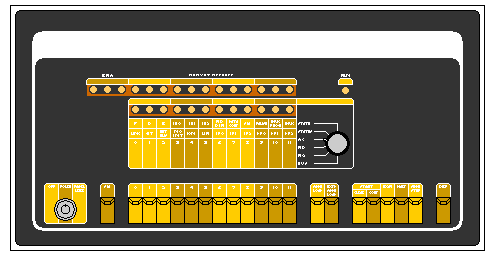
The controls on household appliances, such as washing machines, sometimes have legends which also have rounded corners which flow from one place to another. From where this particular styling had originated to become fashionable, I cannot say. But I will note that the original air date of Encounter at Farpoint was September 28, 1987, some 15 years later than 1972, when the PDP-8/f was introduced.
The same computer, when sold for OEM applications, was designated the PDP-8/m.
The PDP-8 was very popular because of its low cost, which allowed many scientists to use it as part of the setup for experiments. The original PDP-8, in 1965, sold for $18,000. Of course, in today's money, that would be the equivalent of $180,000 or more, and thus I was amused to find that NEC had made a single-processor version of one of its supercomputers, the SX-6r, available at the price of $180,000.
Being the least expensive computer out there, it was also often used in education, to teach children how to program a computer in BASIC or FOCAL, an interpretive language like BASIC which DEC sold for the PDP-8.
Because DEC was the first company to make minicomputers, its systems had been oriented towards 6-bit characters, with word sizes of 12, 18, and 36 bits, as were originally popular. Most minicomputers made by companies that entered the field later had a 16-bit word. The Honeywell 316 and the Hewlett-Packard 2116 are examples of 16-bit minicomputers that had an architecture similar to that of the PDP-8 or the PDP-15, single word instructions with addresses that could refer to the current page or to page zero.
Other 16-bit computers were quite different in architecture. Interdata made a computer that implemented a subset of the IBM System/360 instruction set. The Data General NOVA computer used four registers and had an instruction set that made very efficient use of the available opcode space. Some 16-bit minicomputers let you microprogram them yourself.
The PDP-11 was very different from the PDP-8 or PDP-15. It had an orthogonal two-address instruction format that let either operand be in any of several addressing modes. The Texas Instruments 9900 microprocessor had a strikingly similar instruction format, but many other microprocessors, from the 6502 to the 8086, are often claimed as being influenced by the PDP-11 architecture as well.
The PDP-11 had eight registers which an instruction could reference; the stack pointer and the program counter were included in that set, thus allowing a number of very useful addressing modes which are paid for by reducing the number of general registers to six instead of by reducing the available space for possible opcodes.
The first PDP-11, the PDP-11/20, had a general style of front panel very similar to that of the PDP-8/e, and its color scheme was based on... shocking pink and mauve. Or, if you prefer, light and dark reddish-purple. This was continued on later PDP-11 front panels.

While this may be considered a chromatic atrocity, a fitting companion to the other horror, consistent little-endian operation, which this machine inflicted upon the computing world, it should be noted that the available pairs of similar, yet contrasting, colors not already used with other machines were limited.
And, while some very minor things may have been wrong about the PDP-11, the fact that it had highly orthogonal addressing and general registers helped it provide very good performance for its price, and a very good assortment of software was offered for it, making it one of the most popular models of minicomputer.
Because very many PDP-8 computers were sold, it had an extensive library of software. This was also true of the PDP-11; but, because it was a more powerful machine, more often sold in larger configurations, its software came closer to that of mainframe systems in its capabilities.
Note that the front panel shows the address and data buses and some status bits, but no internal CPU registers. Of necessity, this was also a characteristic of the front panels of the Altair 8800, the Imsai 8080, and the Ithaca InterSystems DPS-1, S-100 bus microcomputers that had front panels. Thus, it could be said to mark the beginning of the end for the computer front panel.
In order to include subtle gradations of shading as required to produce a 3-D modelling effect in the diagrams below, some colors that are not internet-safe have been used. This can result in a mottled appearance of the diagrams below on systems still using 256-color mode to view the Web. |
The PDP-11/20 first shipped in June, 1970. Its successors, the PDP-11/45 (which shared its front panel design with the PDP-11/50) from June, 1972,
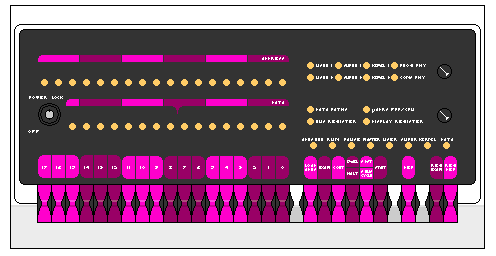
the PDP-11/40 (which shared its front panel design with the PDP-11/35) from January 1973,
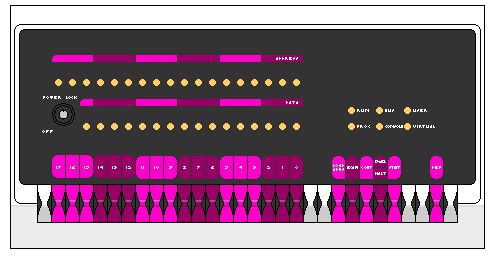
and the PDP-11/70 from March, 1975,
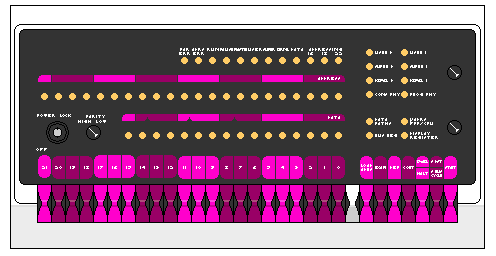
had very stylish front panels which I have only now attempted to depict.
The PDP-11/55, which first shipped in June, 1976, had the same basic front panel design as the PDP-11/45,

but with significant restyling similar to that which took place between the PDP-15 and the XVM, although its CPU design was closer to that of the PDP-11/70. One feature of the PDP-11/45 was omitted, though: cache memory. This was because all of its memory was composed of bipolar semiconductors, for extremely high performance. Presumably, the option of a 22-bit address space was also left out, which allowed the PDP-11/45 front panel design could be used, because no one would have been able to afford that much bipolar memory (4 megabytes as opposed to 256 kilobytes, since the PDP-11 used byte addressing and not word addressing). Of course, that does not seem like much these days, but the pace of progress has been so fast that it is easy to forget how expensive and limited computers once were.
Later models of the PDP-11, such as the PDP-11/34 did not have front panels as such. The PDP-8/A was similar in styling to the PDP-11/34, but it did have some degree of front panel control, with a calculator-style keyboard and display on its front panel.
The PDP-11 was succeeded by the VAX, a 32-bit architecture with a PDP-11 compatibility mode.
As noted on the previous page, a PDP-11/40 with a customized front panel was attached to the KL-10 processor version of the PDP-10, which did not have a front panel of its own:
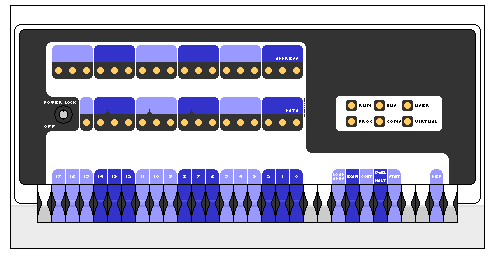
Such a PDP-11/40 was also used with the DECSYSTEM-20 model 2050, as shown in this image from an advertisement:
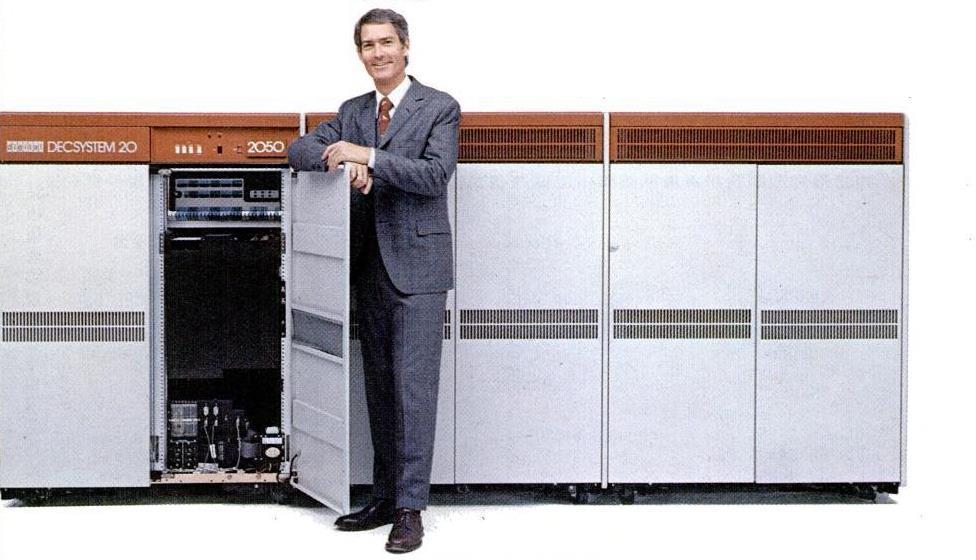
This is not surprising. While the DECSYSTEM-2020 achieved its small size and low price by incorporating both an AMD bit slice ALU and an AMD bit slice register file into its construction, the remaining models in the DECSYSTEM-20 series were based on the KL-10 CPU. (Incidentally, the CPU of the DECSYSTEM-2020 was referred to as the KS-10.)